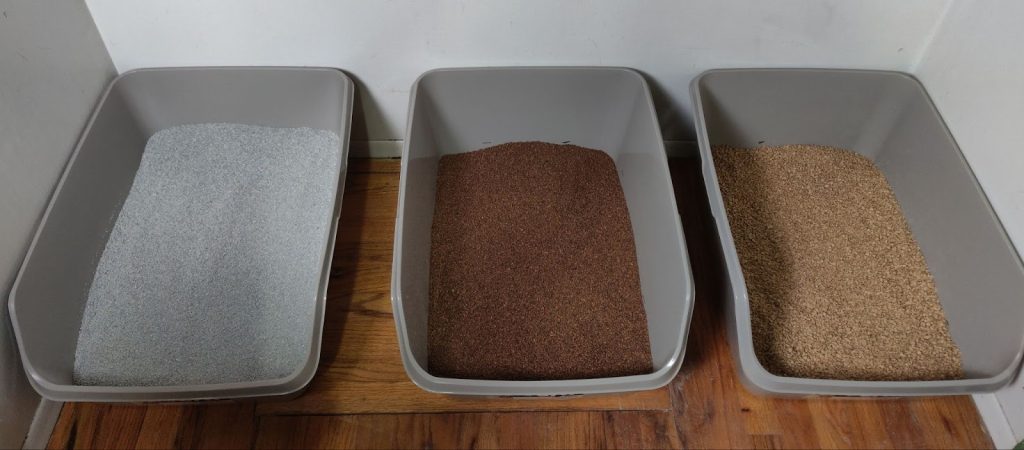Pets and Their People Blog
Choosing Cat litter -Part One: What Is a Preference Test?
Nowadays, there are many different kinds of cat litter to choose from. The purpose of this series is to compare different kinds of cat litter. This comparison will help consumers decide what kind of litter you want to try, and help you set up a preference test to determine what kind of litter your cat(s) will use.
A note about litter for kittens: Nontoxic, non-clumping litter is recommended for kittens so that, if they ingest it, there’s no danger of their digestive tract being blocked up. Some people choose to use pellet litter for this reason, and then transition the cat onto regular litter when they’re older. Cobbled paper could be another option. For picky kittens, coconut litter could be used initially. (Although, it makes a mess when kittens tip over the tray.) I can’t imagine using coconut litter continuously for a litter of kittens, as the cost would be outrageous for me!
Features Important to Cats
The most important consideration in choosing a litter is whether the cats will use it.
You can go through all the effort to find a litter that ticks all the boxes for you, but it doesn’t matter if the cats won’t use it.
Texture
Close-up images of different kinds of cat litter, showing texture: clay, coconut, grass, wood, wheat, corn, walnut
(©M. Hampton)
Preference Testing
I have five cats. To determine my cats’ litter preferences, I set up three identical litter boxes side-by-side in one room. (See photo below.)

I randomly assigned a different kind of litter to each box and recorded usage over a period of three days, scooping litter twice a day. Then, I shifted the boxes’ position so that the left box moved to the center, the center box moved to the right, and the right box moved to the left. I recorded usage for another three days.
Finally, I shifted the boxes once more, so that each box had been in all three positions. Since my cats are used to clumping clay litter, I provided that as one of the options.
When I did an assessment test to determine if litter preference was associated with litter box position, I found no significant difference.
I did another round of experiments where I offered three different kinds of litter side-by-side, but I did not shift the position of the boxes. I then mixed the different types of litter with clay litter 50/50, to see if the cats could potentially get used to a different kind of litter.
I ran these trials over a period of two or more days, and I recorded the number of daily uses as well as the percentage of daily use in each type of litter. In all of the trials, I provided clumping clay litter as a control.
Results

Since clay was consistently the most used in these experiments, I gave it the top ranking.
Next, I did a round of experiments where I offered the types of litter the cats had used most – except for clay – to rank their top picks. (See Table below.)
Finally, I tested to see whether my cats have a significant preference for regular or multi-cat clay litter of the same brand, and I found no significant difference.
| Litter | Material | Texture | Cats use it |
| Integrity clumping clay | clay | coarse sand | ⭐⭐⭐ |
| CatSpot clumping | coconut | soft soil | ⭐⭐⭐ |
| SmartCat grass | grass | coarse sand | ⭐⭐✰ |
| ökocat® super soft | wood | coarse sand | ⭐⭐✰ |
| sWheat Scoop multi-cat | wheat | chips | ⭐⭐✰ |
| World’s Best multiple cat unscented | corn | chips | ⭐⭐✰ |
| Sustainably Yours large-grains | corn | tiny beads | ⭐✰✰ |
| Naturally Fresh herbal attraction® | walnut | chips | ⭐⭐✰ |
Key
| ⭐⭐⭐ = cats used it more than once a day, on average ⭐⭐✰ = cats used it about once a day, on average ⭐✰✰ = cats used it less than once a day, on average ✰✰✰ = cats did not use it |
Recommendations
Use unscented litter, as strong scent can be a deterrent to cats, leading to litter box avoidance and accidents outside of the box.
In my experience, if you’re looking for a litter that cats will use reliably, look no further than clumping clay. I like Integrity brand because it’s more sustainable than traditional clay litter.
For a biodegradable alternative, I recommend CatSpot coconut husk litter. My cats used it about as much as clay. The downside to this litter is it’s only available online and it’s quite expensive.
In the next post of this series, I will compare litter by not only sustainability and cost, but some other cat litter features that are important to people as well: clumping, amount of dust, tracking, and odor control.
About the Author

Misty Hampton (CCBC, FFCP) is a cat trainer and behavior consultant and owner of Fellow Creatures Pet Consulting. She started teaching at age 12. For 13 years, she was an instructor for a home-schooling community. Since 2001, she has been a math and science tutor. Now, she is a life coach for teens and young adults as well. She also runs a birding club for Lake Oswego Parks & Recreation.
Her passion is helping people better understand misunderstood animals. She shares her life with her husband Jesse and their five cats: Linus, Jasper, Abigail, Pearl, and Piper.

